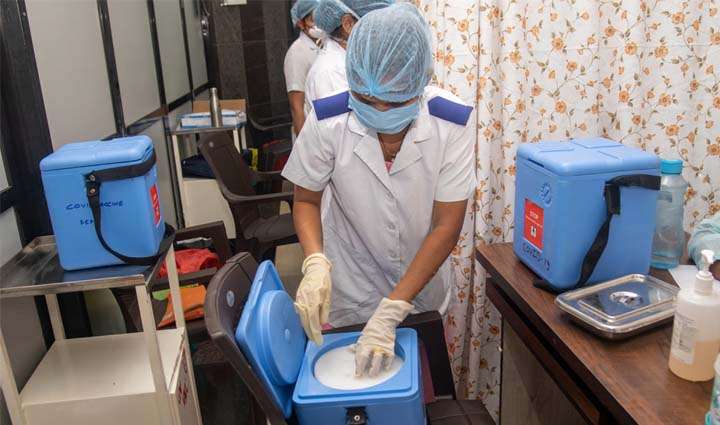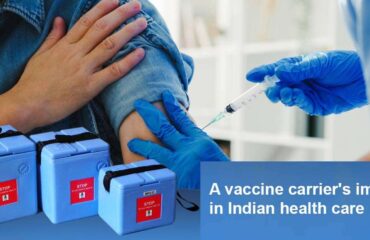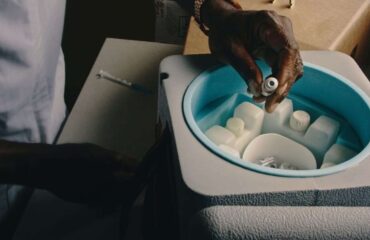A vaccine carrier is a portable, insulated container designed to store and transport vaccines at the correct temperature, typically between +2°C and +8°C. It is commonly used in immunization programs, especially in remote or hard-to-reach areas where refrigeration may not be available.

Uses of Vaccine Carriers
Vaccine carriers play a critical role in public health and immunization programs by ensuring vaccines remain at the correct temperature during transport and storage. Below are the detailed uses of vaccine carriers:
Transportation of Vaccines to Remote and Rural Areas
- In many parts of the world, healthcare facilities are far from vaccination sites.
- Vaccine carriers help transport vaccines to hard-to-reach areas such as rural villages, mountainous regions, and disaster-affected zones where electricity and refrigeration are unavailable.
- Health workers carry these portable containers on foot, bicycles, motorcycles, or boats to ensure people in remote areas receive immunizations.
Mobile Immunization Programs & Outreach Campaigns
- Government and non-governmental organizations (NGOs) conduct mass vaccination campaigns against diseases like polio, measles, COVID-19, and influenza.
- These programs often require health workers to move across different locations in a single day, making vaccine carriers essential for maintaining vaccine potency during transit.
- Carriers ensure that vaccines are not wasted due to exposure to high temperatures.
Emergency and Disaster Relief Vaccination
- In emergency situations such as earthquakes, floods, refugee crises, and pandemics, vaccine carriers help deliver vaccines to displaced populations and temporary health camps.
- They are crucial for rapid response teams during outbreaks like cholera, Ebola, or COVID-19.
Storage of Vaccines in Clinics with Limited Refrigeration
- In small healthcare centers, particularly in low-income countries, electricity supply may be unreliable.
- Vaccine carriers provide a temporary cold storage solution, ensuring vaccines remain effective until they can be used.
Transporting Vaccines Between Health Facilities
- In some cases, vaccines need to be transferred from a main storage facility to smaller clinics or temporary immunization sites.
- Vaccine carriers ensure that vaccines are kept at the correct temperature during short-distance transfers between facilities.
School-Based and Workplace Immunization Programs
- Some vaccination campaigns are conducted in schools, workplaces, and community centers.
- Vaccine carriers allow health workers to transport vaccines safely from clinics to these locations while maintaining the required temperature.
Supporting Cold Chain Logistics
- The cold chain is the system that ensures vaccines remain at the correct temperature from manufacturing to administration.
- Vaccine carriers act as a last-mile solution, bridging the gap between storage centers and vaccination points.
- Without proper cold chain maintenance, vaccines can lose their potency and become ineffective.
Research and Field Studies on Immunization
- Scientists and researchers studying vaccine efficacy in different environments use vaccine carriers to transport samples and vaccines to study areas.
- These carriers ensure that vaccines maintain their integrity during research trials.
Key Features of a Vaccine Carrier
A vaccine carrier is specifically designed to maintain the potency of vaccines during transport and storage. Below are its key features explained in detail:
High-Quality Insulation for Temperature Control
- The vaccine carrier is made of materials like polyurethane foam or polystyrene that provide excellent thermal insulation.
- It helps maintain the internal temperature between +2°C and +8°C, preventing vaccines from becoming too warm or freezing.
- Insulation reduces heat transfer, ensuring that vaccines remain viable even in hot or cold environments.
Use of Ice Packs or Gel Packs
- Cold packs or gel packs are placed inside the carrier to help maintain the required temperature.
- These packs are pre-conditioned before use to ensure they do not freeze the vaccines.
- Proper placement of ice packs inside the carrier helps in even distribution of cold air.
Compact and Portable Design
- Vaccine carriers are designed to be small and lightweight, making them easy to carry.
- They are often equipped with handles or shoulder straps for easy transport by healthcare workers.
- The compact size ensures convenience during door-to-door vaccination campaigns, mobile immunization programs, and outreach activities.
Durable and Sturdy Construction
- Made from high-density plastic or insulated polymer, vaccine carriers are impact-resistant and water-resistant.
- They are built to withstand rough handling, making them ideal for transportation in rural, remote, and disaster-prone areas.
- Their sturdy construction ensures that they can endure long hours of travel in different weather conditions.
Secure Lid with Locking Mechanism
- The vaccine carrier has a tight-sealing lid to prevent temperature fluctuations.
- Some models have rubber gaskets or locking clips to ensure an airtight seal, reducing heat exchange with the external environment.
- This feature helps in minimizing temperature variations that could damage the vaccines.
Temperature Monitoring Option
- Some modern vaccine carriers come with built-in temperature monitoring devices, such as:
- Temperature indicators (simple color-changing strips to indicate temperature breaches).
- Digital temperature loggers (to track temperature changes over time).
- This feature helps health workers ensure that vaccines remain within the safe temperature range throughout transportation.
WHO Prequalification and Compliance with Cold Chain Standards
- Vaccine carriers used in immunization programs are approved by the World Health Organization (WHO) and other health organizations.
- They must meet strict cold chain equipment standards to ensure they provide effective temperature control for vaccines.
- WHO-prequalified carriers are tested for insulation performance, durability, and ease of use before approval.
Easy-to-Clean Interior
- The inner surface of the vaccine carrier is made of smooth, non-porous material to allow easy cleaning and disinfection.
- Proper hygiene prevents contamination and maintains vaccine safety.
- Cleaning after each use is essential to ensure vaccines remain uncontaminated.
Different Sizes and Capacities for Various Needs
- Vaccine carriers come in various sizes to accommodate different vaccination needs:
- Small carriers (for individual use or short-distance transport).
- Medium carriers (for outreach programs with multiple vaccine doses).
- Large carriers (for mass vaccination campaigns or storage at remote sites).
Reusable and Environmentally Friendly
- Most vaccine carriers are reusable and designed for long-term use.
- High-quality models can last for several years with proper maintenance.
- Some vaccine carriers are made from recyclable materials, reducing environmental impact.
Conclusion
A vaccine carrier is an essential tool in immunization programs, helping to maintain the efficacy of vaccines during transportation. Its insulation, durability, portability, and secure sealing make it vital for ensuring vaccines reach all communities safely. These features make it especially useful in remote areas, mobile vaccination programs, and emergency health response situations.


